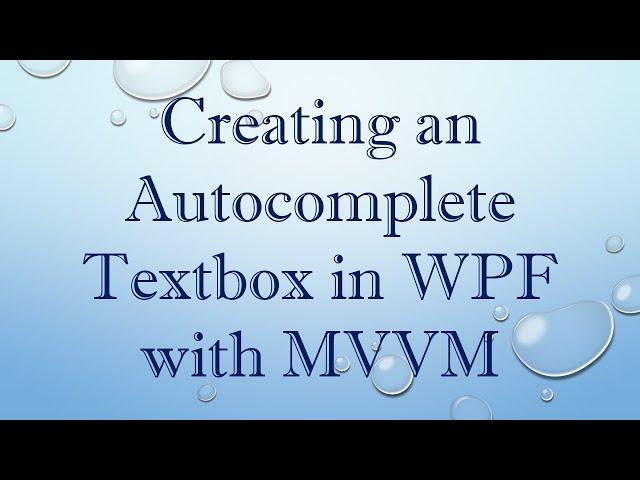
Creating an Autocomplete Textbox in WPF with MVVM
Discover how to implement an autocomplete textbox in WPF using MVVM pattern and WPF Toolkit. A step-by-step guide for creating an autocomplete textbox in C# WPF.
---
Disclaimer/Disclosure: Some of the content was synthetically produced using various Generative AI (artificial intelligence) tools; so, there may be inaccuracies or misleading information present in the video. Please consider this before relying on the content to make any decisions or take any actions etc. If you still have any concerns, please feel free to write them in a comment. Thank you.
---
Creating an Autocomplete Textbox in WPF with MVVM
Autocomplete textboxes can significantly enhance user experience by offering suggestions as users type. This guide will guide you through the process of creating an autocomplete textbox in WPF using the MVVM pattern and WPF Toolkit. We'll also cover the basics of how to create an autocomplete textbox in C WPF.
Why Use Autocomplete?
Autocomplete functionality not only helps users by providing suggestions, which can significantly speed up data entry, but it also improves overall application usability. Implementing an autocomplete textbox in a WPF application offers a modern and efficient way to handle text input and search-related functionalities.
Setting Up the Project
Before diving into the code, it's essential to set up your WPF project with the necessary libraries:
Create a New WPF Project: Open Visual Studio and create a new WPF application.
Add WPF Toolkit: To use the WPF Toolkit for autocomplete functionality, you need to add it to your project. You can do this via NuGet Package Manager by installing Extended.Wpf.Toolkit.
Implementing Autocomplete Textbox in WPF
Step 1: XAML Design
First, we need to define the user interface in XAML. Below is an example of how to add an autocomplete textbox using the WPF Toolkit.
[[See Video to Reveal this Text or Code Snippet]]
Step 2: ViewModel Implementation
Next, we need to implement the ViewModel. The ViewModel will interact with the Model and provide the necessary data to the View.
[[See Video to Reveal this Text or Code Snippet]]
Step 3: Wiring Up the DataContext
Finally, we need to connect our ViewModel to the View. This is done in the code-behind file of the MainWindow.xaml:
[[See Video to Reveal this Text or Code Snippet]]
With this setup, you now have a simple autocomplete textbox in your WPF application that adheres to the MVVM pattern.
Conclusion
Creating an autocomplete textbox in WPF, especially using the MVVM pattern and WPF Toolkit, can seem complex at first. However, by following these steps, you can integrate this functionality efficiently into your application. This not only improves user experience but also leverages the power of WPF and MVVM for better application management and data manipulation.
If you have additional requirements or complex scenarios, consider exploring more advanced features of WPF Toolkit and customizing the ViewModel accordingly. Happy coding!
---
Disclaimer/Disclosure: Some of the content was synthetically produced using various Generative AI (artificial intelligence) tools; so, there may be inaccuracies or misleading information present in the video. Please consider this before relying on the content to make any decisions or take any actions etc. If you still have any concerns, please feel free to write them in a comment. Thank you.
---
Creating an Autocomplete Textbox in WPF with MVVM
Autocomplete textboxes can significantly enhance user experience by offering suggestions as users type. This guide will guide you through the process of creating an autocomplete textbox in WPF using the MVVM pattern and WPF Toolkit. We'll also cover the basics of how to create an autocomplete textbox in C WPF.
Why Use Autocomplete?
Autocomplete functionality not only helps users by providing suggestions, which can significantly speed up data entry, but it also improves overall application usability. Implementing an autocomplete textbox in a WPF application offers a modern and efficient way to handle text input and search-related functionalities.
Setting Up the Project
Before diving into the code, it's essential to set up your WPF project with the necessary libraries:
Create a New WPF Project: Open Visual Studio and create a new WPF application.
Add WPF Toolkit: To use the WPF Toolkit for autocomplete functionality, you need to add it to your project. You can do this via NuGet Package Manager by installing Extended.Wpf.Toolkit.
Implementing Autocomplete Textbox in WPF
Step 1: XAML Design
First, we need to define the user interface in XAML. Below is an example of how to add an autocomplete textbox using the WPF Toolkit.
[[See Video to Reveal this Text or Code Snippet]]
Step 2: ViewModel Implementation
Next, we need to implement the ViewModel. The ViewModel will interact with the Model and provide the necessary data to the View.
[[See Video to Reveal this Text or Code Snippet]]
Step 3: Wiring Up the DataContext
Finally, we need to connect our ViewModel to the View. This is done in the code-behind file of the MainWindow.xaml:
[[See Video to Reveal this Text or Code Snippet]]
With this setup, you now have a simple autocomplete textbox in your WPF application that adheres to the MVVM pattern.
Conclusion
Creating an autocomplete textbox in WPF, especially using the MVVM pattern and WPF Toolkit, can seem complex at first. However, by following these steps, you can integrate this functionality efficiently into your application. This not only improves user experience but also leverages the power of WPF and MVVM for better application management and data manipulation.
If you have additional requirements or complex scenarios, consider exploring more advanced features of WPF Toolkit and customizing the ViewModel accordingly. Happy coding!
Тэги:
#autocomplete_textbox_in_wpf #autocomplete_textbox_in_wpf_mvvm #autocomplete_textbox_wpf_toolkit_example #how_to_create_autocomplete_textbox_in_c#_wpfКомментарии:
Как пошить спортивную майку без распошивалки
Пошив и ремонт одежды
КАК Я ЛЕЖАЛ В ДУРКЕ
РОМАН
Tuning Nexia R 3 Moshinam Bomba Holatda bo’ldi Hammaga nasib qilsin
G'ayrat Maxmudov
Ejder Kapanı | Bırakacaksın Artık Pavyonu
Enis Özkan Film


























